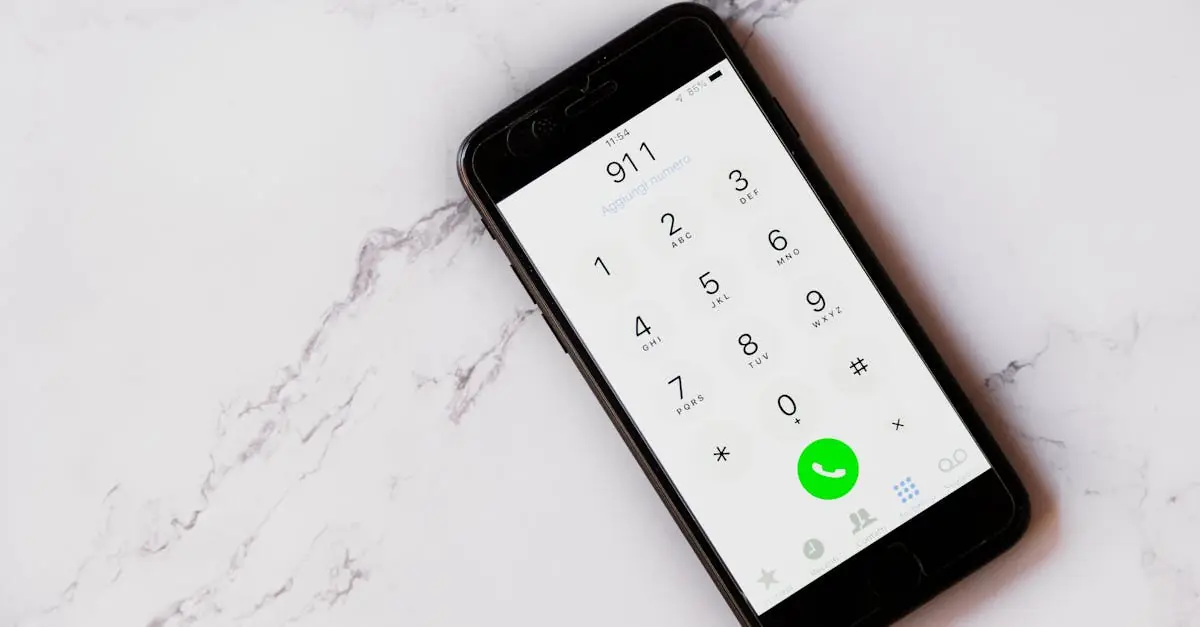Imagine you’re out and about, ready to capture that perfect sunset selfie, when suddenly your iPhone decides it’s time to play superhero and goes into SOS mode. Panic sets in as you wonder if your phone’s trying to send an emergency signal or just needs a coffee break.
Table of Contents
ToggleUnderstanding SOS Mode on iPhone
SOS mode on iPhone serves as a safety feature designed for emergency situations. It enables users to quickly contact emergency services, even without cellular service in some cases. When activated, it displays “Emergency SOS” on the screen and may initiate a series of actions such as sounding an alarm or sharing location details with emergency contacts.
Users often find their device entering SOS mode accidentally. Factors such as unintentional button presses can trigger this feature. The side button and one of the volume buttons usually activate SOS mode when pressed simultaneously. This process reflects Apple’s design intention to make emergency access simple.
In certain conditions, the iPhone might enter SOS mode due to software glitches or connectivity issues. For instance, strong interference can disrupt normal signals, leading the device to mistakenly believe it’s in an SOS situation. Connectivity drops can also result in false triggers.
It’s important for users to understand how to manage SOS mode effectively. Familiarizing oneself with the settings helps prevent unwanted activations. Exploring the settings section provides options for managing emergency contacts and modifying the SOS functionality.
Regular software updates enhance the reliability of SOS mode. Apple continually works to refine the feature, addressing user feedback and resolving potential issues. Ensuring that the iPhone runs the latest software version enhances overall performance and can reduce unwanted SOS triggers.
Learning about SOS mode empowers users to use their iPhone confidently, especially in emergencies. Understanding its purpose and how it operates allows for better preparation when unexpected situations arise.
Common Reasons for SOS Mode Activation
SOS mode can activate due to various reasons. Understanding these reasons helps users manage their devices effectively.
Network Issues
Network issues frequently cause an iPhone to enter SOS mode. Weak cellular signals can mislead the device into thinking it lacks connection. When there’s no service available, the iPhone may initiate SOS mode to ensure safety. This activation occurs especially in remote areas or while traveling where coverage varies. Users often find themselves facing this situation during emergencies when they’re far from accessible networks.
Software Glitches
Software glitches can mistakenly trigger SOS mode on an iPhone. Bugs in the operating system may result in unexpected behaviors. Occasionally, recent updates lead to compatibility issues, causing the device to malfunction. Users who encounter this usually find that a quick restart resolves the problem. Keeping software updated minimizes the chances of bugs and improves the overall functionality of the device.
Hardware Malfunctions
Hardware malfunctions also play a significant role in SOS mode activation. Physical damage, such as a faulty side button or volume button, can lead to unintentional triggers. Aging components can cause erratic behavior, including unwanted SOS activation. Users should look for signs of hardware damage to determine if repairs are necessary. Regular maintenance and careful handling help prevent hardware-related SOS issues.
Steps to Troubleshoot SOS Mode
Troubleshooting SOS mode involves several straightforward steps. Users can resolve this issue effectively by following these methods.
Restarting Your Device
Restarting the device often resolves temporary glitches. To restart, press and hold the side button along with the volume button until the power-off slider appears. Once the slider shows up, slide to power off. After a few moments, press the side button again until the Apple logo appears. This simple action can restore regular functionality and eliminate accidental SOS mode activation.
Checking SIM Card
Checking the SIM card is crucial for accurate network connectivity. Users should turn off their iPhones before removing the SIM card tray. Inspect the SIM card for any damages or dirt, then reinsert it securely. After placing the tray back, power on the device. A secure connection to the network often resolves unexpected SOS mode issues.
Updating iOS Software
Updating iOS software can enhance device performance and fix bugs. Navigate to Settings, then tap General, followed by Software Update. If an update is available, users should download and install it promptly. Keeping the software current ensures that all features, including SOS functionality, work as intended. Regular updates from Apple address known issues reported by users.
Preventing Future SOS Mode Issues
Regular maintenance is crucial for avoiding unwanted SOS mode activations. Users should prioritize keeping their iPhone software up to date with the latest iOS updates. These updates enhance performance, fix bugs, and refine the SOS feature. Apple frequently releases updates based on user feedback, ensuring devices work reliably. To check for updates, navigate to Settings, then to General, and tap Software Update.
Maintaining network settings helps avoid false SOS mode entries. Users should periodically reset their network settings to keep cellular connectivity stable. This can be accomplished by opening Settings, selecting General, then Reset, and tapping Reset Network Settings. Important information like Wi-Fi passwords gets erased, so it’s wise to have them written down. Ensuring the iPhone reconnects to known networks correctly minimizes issues caused by poor connectivity.
Understanding why an iPhone goes into SOS mode is essential for every user. This safety feature can be both a lifesaver and a source of frustration when activated unintentionally. By recognizing the common triggers and knowing how to troubleshoot them, users can minimize disruptions and ensure their devices function smoothly.
Regular maintenance and software updates play a crucial role in preventing unwanted activations. Familiarizing oneself with the settings and emergency features can empower users to navigate their iPhones confidently. With the right knowledge and proactive measures, users can enjoy their devices without the worry of unexpected SOS interruptions.





